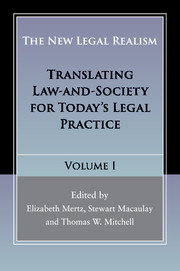Book contents
- Frontmatter
- Contents
- List of contributors
- Preface to The New Legal Realism, Volumes I and II
- 1 Introduction: New Legal Realism: Law and Social Science in the New Millennium
- Section I THE PLACE OF NEW LEGAL REALISM IN LEGAL THOUGHT AND TEACHING
- Section II PHILOSOPHY AND METHODS FOR A NEW LEGAL REALISM
- 6 Legal R/realism and Jurisprudence: Ten Theses
- 7 Legal Realism in Context
- 8 Legal Storytelling as a Variety of Legal Realism
- 9 Combining Methods for a New Synthesis in Law and Empirical Research
- Section III NEW LEGAL REALIST TRANSLATIONS
- Index
- References
6 - Legal R/realism and Jurisprudence: Ten Theses
from Section II - PHILOSOPHY AND METHODS FOR A NEW LEGAL REALISM
Published online by Cambridge University Press: 05 May 2016
- Frontmatter
- Contents
- List of contributors
- Preface to The New Legal Realism, Volumes I and II
- 1 Introduction: New Legal Realism: Law and Social Science in the New Millennium
- Section I THE PLACE OF NEW LEGAL REALISM IN LEGAL THOUGHT AND TEACHING
- Section II PHILOSOPHY AND METHODS FOR A NEW LEGAL REALISM
- 6 Legal R/realism and Jurisprudence: Ten Theses
- 7 Legal Realism in Context
- 8 Legal Storytelling as a Variety of Legal Realism
- 9 Combining Methods for a New Synthesis in Law and Empirical Research
- Section III NEW LEGAL REALIST TRANSLATIONS
- Index
- References
Summary
INTRODUCTION
At Oxford, Salmond on Torts had been my favorite textbook (Salmond 1953). It was a conventional, lucid, expository work. Shortly after I had graduated in 1955, a solicitor specializing in personal injuries told me to forget what I had learned in the books because nearly all of his cases were settled out of court with an insurance company or the Motor Insurers’ Bureau involved. Anyway, he said, the system needed drastic reform. I suffered culture shock. So I began to wonder: how could one understand the law relating to personal injuries if one knows nothing about insurance, settlement, the damages lottery, and alternatives to the common law action for negligence? I felt misled, let down, even betrayed by Salmond and my teachers. This is a common complaint by students in most modern legal systems. Of course, I was naïve, for no one in Oxford had claimed that what they were offering was in any way realistic. Brian Leiter cites a colleague as saying: “Anyone teaching constitutional law who discusses only the doctrine is guilty of educational malpractice” (Leiter 2003, citing Powe 2001). That was how I felt about Torts. But the context in England was different. When I complained, I was met with standard, complacent answers:
“We do not claim that we are preparing you for practice.”
“You will learn about such matters when you study procedure.” (This was untrue; the bar exams were just as doctrinal.)
“Be realistic, you need to mug up Salmond to pass both degree and professional examinations.”
“Such pedestrian matters are just common sense.”
And, more convincingly:
“Studying the law in action presupposes that you have a clear idea about what is in action. So your practitioner friend was wrong, you need to study the books before getting involved in the action.”
The purpose of this paper is to restate some basic points about Legal R/realism as an aspect of Jurisprudence. Most of the general theses should be familiar and, I hope, acceptable to most sociolegal scholars, but a few points may appear to be provocative.
Classical American Legal Realism (ALR) reacted against an ill-defined “formalism” in academic law in the period before World War II.
- Type
- Chapter
- Information
- The New Legal RealismTranslating Law-and-Society for Today's Legal Practice, pp. 121 - 146Publisher: Cambridge University PressPrint publication year: 2016
References
- 3
- Cited by



